American Whiskey |
||
|
A.
Guckenheimer & Bros. Distillery We found it! Here it is! No, wait... it's HERE No, it's over HERE!!
|
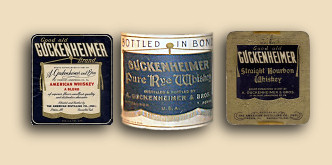 |
|
BUFFALO CREEK empties into the Allegheny river right about where four Pennsylvania counties (Allegheny, Butler, Armstrong, and Westmoreland) come together near the pretty little town of Freeport.
This tiny Armstrong County community is home to around 530 families, none of whom appear to be aware there was once a very important whiskey distillery here. In fact, there appears to have been at least two, both of them known as the Guckenheimer distillery. Except when they were called the Pennsylvania Distilling Company.
In spring of 2003, we spent much of an afternoon exploring, repeatedly,
all eight or so blocks of Freeport in search of any clue to either
distillery's former location. To no avail. We finally gave up and moved
on, vowing to one day learn more about the A. Guckenheimer & Bros.
Company and the distillery where they produced Good Old Guckenheimer,
perhaps the most prestigious of the so-called "Monongahela" whiskeys.
Why "so-called"? Well, the name Monongahela comes from the
Monongahela River Valley, which came to be identified with a specific type
of whiskey. Made from rye grain, with little or no corn (maize), it
featured a deep, reddish-brown color and a distinctive flavor. East Coast rye whiskey, sometimes called Maryland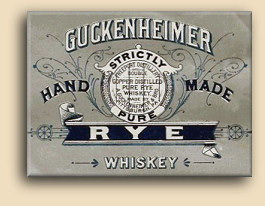 rye (although also including rye from Pennsylvania east of the Appalachian
Mountains) was not really the same kind of spirit,
often being unaged or very young, and usually being made from both rye and
corn grains. Bourbon, a whiskey also said to be
named for the location of its origins, is made mostly from corn and has a
distinctive flavor of its own.
rye (although also including rye from Pennsylvania east of the Appalachian
Mountains) was not really the same kind of spirit,
often being unaged or very young, and usually being made from both rye and
corn grains. Bourbon, a whiskey also said to be
named for the location of its origins, is made mostly from corn and has a
distinctive flavor of its own.
Most of the "bourbon" distilleries were not actually located in what is today Bourbon county (although the county was once much larger); in fact none of them are. Likewise, most of the western Pennsylvania rye distillers were not located along the Monongahela River (locally, "The Mon"). One of the best-known, Old Overholt, was built on a tributary of "The Mon", the Youghiogheny River ("The Yock"). Another important river in this region is the Allegheny, which flows from the mountains of the same name and ends up combining with "The Mon" to form the Ohio River. Where that happens is called Pittsburgh, and a great number of fine so-called Monongahela distilleries once dotted the banks of the Allegheny upstream of Pittsburgh. Among them was that of Asher Guckenheimer & Brothers.
And, no, there isn't a similar name for the Allegheny
River, such as "The Alley".
People here just call it the Allegheny River.
Monongahela rye isn't a whiskey for the debonair. It's pretty rough 'n' tumble stuff, the character of which was shaped by it's long and arduous journey from where it was distilled to where it was consumed. Locally, the whiskey was probably drunk unaged, the same as any other whiskey was at that time. The product that made its way to Baltimore, New York, Boston, and Philadelphia, though, had developed a character more similar to what we, today, expect whiskey to have... except a bit less genteel. But then, the big-city tavern patrons who bought it weren't drinkers of "whiskey" anyway. That was a drink for country-bumpkins and the unsophisticated. Fashionable tavern patrons who bought Monongahela most likely thought it was a type of rum. Later, when the product began to be recognized for what it was, Monongahela began to lose some of its social appeal. But not all brands. Guckenheimer Pure Rye Whiskey held a reputation as an award-winning liquor and was sold as top-shelf liquor throughout its entire pre-prohibition existence.
That was before it went on to become part of the Schenley empire, which itself began with the acquisition of many of the Allegheny Valley distilleries.
And that was before it went further on to become a product of the American Distilling Company in Pekin, Illinois, and the Heaven Hill Distilling Company in Bardstown, Kentucky.
But long before any of this happened , there was Thomas Bell.
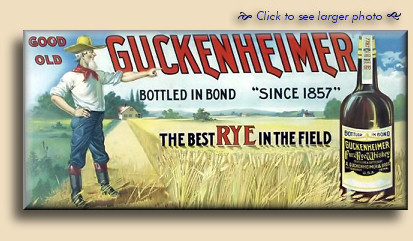
Or was that Thomas Bole?
Or maybe John Bole, and Thomas McGill?
Or John Moyer
Or Henry S. Weaver.
Or Williamson & Rhey
Or P. McGonigle & Son
Or McGonegal, Helmbold & Co.
It all depends on whose stories you're reading, and what order you're
reading them in.
Let's take a look at a few...
According to "The Story of Pittsburgh" published by the Pittsburgh
Gazette-Times in 1908 (available online through the
Penn State University Library Digital Collection), one of several early distillers along the Allegheny
River was Thomas Bell, who built his distillery in Freeport in 1846.
The whiskey that Bell produced is said to have enjoyed a regional reputation for excellence, and when Asher
Guckenheimer and his half-brother,
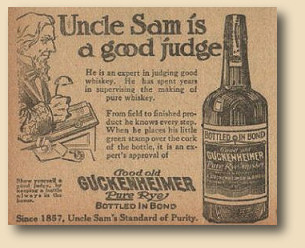 Samuel Wertheimer, established a
Pittsburgh mercantile shop in 1857, they became known for their
private brand of rye whiskey, which they obtained from Bell. Bell's
operation was very small, only about 2,000 barrels annual production, and
the Guckenheimer brothers contracted Bell's entire output. Although
Guckenheimer was Bell's sole customer, the Gazette-Times doesn't indicate
whether Bell was the merchant's only provider.
Samuel Wertheimer, established a
Pittsburgh mercantile shop in 1857, they became known for their
private brand of rye whiskey, which they obtained from Bell. Bell's
operation was very small, only about 2,000 barrels annual production, and
the Guckenheimer brothers contracted Bell's entire output. Although
Guckenheimer was Bell's sole customer, the Gazette-Times doesn't indicate
whether Bell was the merchant's only provider.
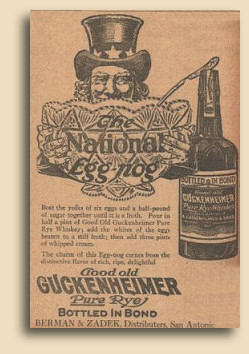 What
they do say is that, upon Thomas Bell's death, they purchased the
distillery itself, although the year of that event isn't given. Apparently
the small capacity of the distillery immediately proved inadequate, however,
and they began designing and building a much more pretentious facility
with greatly-increased capacity and all modern equipment. Nothing more is
said of the Thomas Bell distillery, but the Gazette-Times article implies
that the new plant was not built at the same location.
What
they do say is that, upon Thomas Bell's death, they purchased the
distillery itself, although the year of that event isn't given. Apparently
the small capacity of the distillery immediately proved inadequate, however,
and they began designing and building a much more pretentious facility
with greatly-increased capacity and all modern equipment. Nothing more is
said of the Thomas Bell distillery, but the Gazette-Times article implies
that the new plant was not built at the same location.
There was further expansion in 1868. In that year the Guckenheimer Brothers purchased a distillery in Upper Sandusky, Ohio, which produced a brand named "Wyandotte". The logistics of trying to manage it from Pittsburgh, however, were too great and they quickly sold it off.
In 1876 they purchased the McGonegal, Helmbold, & Co. distillery in Buffalo Township, Butler county, which was doing business under the name Pennsylvania Distilling Company. That distillery produced a regionally successful brand named "Montrose" which also became a nationally distributed brand of no small fame. Shortly after the new Freeport distillery was completed, the Buffalo Township plant burned down and was immediately replaced with a new facility built along the same lines as the Freeport site. The new Montrose distillery produced about 12,000 barrels annually.
The Gazette-Times notes that Asher Guckenheimer operated
these two distilleries until his death in 1893, at which time the business
passed to his partners, his son, and their sons. There is no mention of
any other distilleries being involved.
The
Robert E. Snyder Whiskey Brand Database,
basically tracks the same information, although it puts the Thomas Bell
distillery's output at around 6,000 barrels a year, or about triple the
Gazette-Times' estimate.
The database, one of the most extensive existing, doesn't mention the Pennsylvania Distilling
Company at all, nor can any reference to McGonegal, Helmbold, & Co. be
found there, but it does include
"Montrose" among the brands whose trademarks were registered by A.
Guckenheimer & Bros.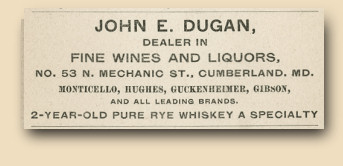 Other brands registered to Guckenheimer were "Fairy
Breath", "Freeport", "Golden Cupid Rye",
and "Pennbrook."
Other brands registered to Guckenheimer were "Fairy
Breath", "Freeport", "Golden Cupid Rye",
and "Pennbrook."
Both of these sources mention that Guckenheimer took top honors at the
1893 Columbian Exposition in Chicago, scoring an incredible 99¼ points out of a possible
100. The Gazette-Times history also notes that theirs was the highest score
earned by any whiskey presented at the Exposition. 1893 was also the year Asher
Guckenheimer died, leaving the firm in the hands of his son, Isaac, and
his two half-nephews, Emanuel and Isaac Wertheimer. It appears to be
generally agreed that they successfully maintained Guckenheimer Pure Rye
as one of the most prestigious brands in America until it finally closed
in 1918.
Now that we have a pretty good idea of the Guckenheimer Bros. and their
whiskey, along comes the Buffalo Township chapter of
The History of Butler County,
Pennsylvania, published in 1895 by R. C. Brown Co., which makes no
mention at all of Thomas Bell, nor of a Guckenheimer distillery in Freeport,
describing Guckenheimer as being located in
Buffalo township, Butler county, across Buffalo Creek from Freeport. This
history describes the
site as consisting of one large brick distillery building and two bonded
warehouses, and claims it was built in 1869 for P. McGonigle & Son,
who began
distilling 18 barrels a day there in 1870. In 1875, the distillery was sold to Asher Guckenheimer, Samuel Wertheimer, Emil Wertheimer and Isaac
Wertheimer.
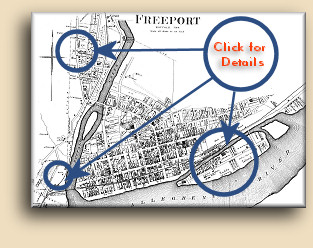 The
Brown history also states that this distillery was operated as the
Pennsylvania Distilling Company, and continued to be so after the
sale. And also that it burnt to the ground in July of 1883, being
immediately replaced with a much larger plant, built on the same site. The
new distillery, with a 50-gallon per day capacity, was in operation when
the history was published in 1895.
The
Brown history also states that this distillery was operated as the
Pennsylvania Distilling Company, and continued to be so after the
sale. And also that it burnt to the ground in July of 1883, being
immediately replaced with a much larger plant, built on the same site. The
new distillery, with a 50-gallon per day capacity, was in operation when
the history was published in 1895.
Pretty impressive, except that we were unable to find a reference to P. McGonigle & Son in
any of the other published histories. But this map,
drawn in 1876, clearly shows, at the location described, a site labeled,
Distillery - McGonegly & Helmbold. We believe the name
McGonegly is likely
a corruption of McGonegal. We've discovered several such
corruptions in historic accounts, including some others we'll mention here
later.
The Brown history also fails to mention Guckenheimer's
proud accomplishment at the 1893 Columbian Exposition (even though that would have been a recent
event in 1895). One might explain that omission as a result of the history,
being oriented, as it was, on
Butler, not Armstrong, county, and focusing only on their relationship with the
local distillery. However, they also make no reference to the
Montrose brand, which the Gazette-Times and the Snyder database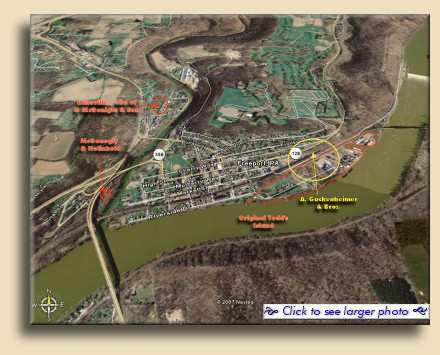 indicate was the major, and perhaps the only, brand of whiskey distilled
there.
indicate was the major, and perhaps the only, brand of whiskey distilled
there.
Or at least that was true of McGonegal, Helmbold & Co.
But then we received a letter from J. Scott Bevan about a year and a half ago, confirming his belief that the original distillery was, indeed, the P. McGonigle & Son distillery, located on the Butler county side of Buffalo Creek. He also confirmed that it was destroyed by fire and re-built. However, Scott placed the distillery, not directly across the creek from Freeport, but in Laneville, which is north of that area. Part of Laneville lies in Armstrong county, and part in Butler. The map, which is focused on Buffalo Township, doesn't show much detail beyond the Butler county line, so we can't determine from that whether a distillery existed here as well. But if both Scott and the Brown history are correct, then P. McGonigle & Son may have been a separate enterprise from McGonegal, Helmbold & Co. Then again, perhaps Mr. Bevan's information was taken from the Brown history.
But if there were, indeed, two similarly-named distilleries,
might not Guckenheimer have been involved with both of them? Like the
Brown history, Bevan doesn't mention the Montrose brand; perhaps
P.
McGonigle & Son produced Fairy Breath or Pennbrook?
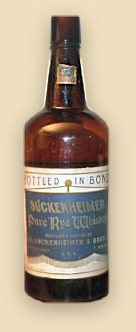 Perhaps
both were distilleries owned by Pennsylvania Distilling Company and
were acquired by Guckenheimer as part of the same transaction?
Perhaps
both were distilleries owned by Pennsylvania Distilling Company and
were acquired by Guckenheimer as part of the same transaction?
The map also shows references to a much larger distillery on Todd's Island
in the Allegheny River, but does not totally identify it. There are
properties labeled "A.G. & Bros" on the 1876 map, which we feel pretty
certain refers to Guckenheimer, but we see none in the area where those
distillery buildings are shown. There is writing obscured by the pattern
in the channel area, but enough can be seen to eliminate it's being
"Guckenheimer". Nevertheless, we can see that there certainly was a
large distillery here, and we believe that was (at least for awhile) the
site of the A. Guckenheimer & Bros. distillery.
The reason we bring all this up is that there are more
inconsistencies among the various histories, some of which cannot be so
easily dismissed as the spelling or pronunciation of a name (although
there's more of that, too).
Now, according to Robert Walker Smith, author of The History of Armstrong
County (Waterman, Watkins & Co. - Chicago), published in 1883
(available online through the
Armstrong County Pennsylvania Genealogy Project (PAGenWeb), one of
Freeport's original founders, Jacob Weaver, was operating a distillery in
Freeport as early as 1811.
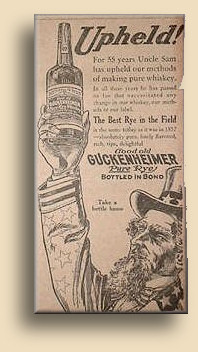 The
county tax assessment list for 1818 shows a distillery in Freeport
belonging to Henry S. Weaver, but does not provide a location. The 1876
map shows a large tract adjacent to the distillery area that is owned by a
P. S. Weaver. Could Henry Weaver's property have been where the distillery
buildings are shown?
The
county tax assessment list for 1818 shows a distillery in Freeport
belonging to Henry S. Weaver, but does not provide a location. The 1876
map shows a large tract adjacent to the distillery area that is owned by a
P. S. Weaver. Could Henry Weaver's property have been where the distillery
buildings are shown?
Smith, however, claims that the Guckenheimer Brothers
purchased their distillery, not from Henry Weaver but from the Williamson & Rhey Company, who began
distilling there in 1855. In Smith's history, Guckenheimer purchased the
distillery from them in 1866. There is no mention in this history of a
Thomas Bell, nor of his death, nor of any distillery operating in Butler
county in the 1840s.
The A. Guckenheimer & Bros. Company (and perhaps the Williamson & Rhey
Company before it) was no small operation, either, according to the Robert
Smith history. In 1876, there were all of 357 employed persons living in
Freeport, of which 25 worked for the distillery. The facilities included a
3-story brick distillery building, a grain-house holding 30,000 bushels, a
150-ton capacity ice-house, a 3-story brick malt-house capable of malting
100 bushels per day, a 50-barrel/day cooper-shop, and a 3-story brick
bonded warehouse with a capacity of 8,000 barrels. They normally operated
at 50% of their 500 bushels/day capacity, producing 22 42-gallon barrels a
day. Smith also notes that they supported 100 cattle and 500 hogs on daily
slop production.
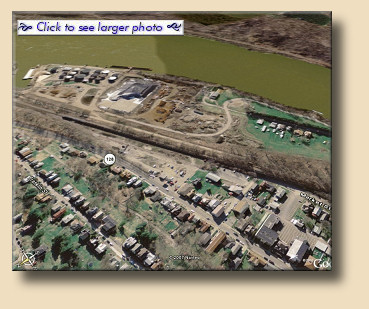 The
size of the main distillery building leads us to believe they did not
operate a continuous (column-type) still at that time, since these
typically require a taller structure, although it would be possible if the
first story were a basement.
The
size of the main distillery building leads us to believe they did not
operate a continuous (column-type) still at that time, since these
typically require a taller structure, although it would be possible if the
first story were a basement.
Interestingly, the Gazette-Times article, in their description of the large, modern facility built immediately after purchasing the smaller one, also portrays a state-of-the-art plant, a model for modern distilling in mid-19th century America. The distillery they describe, however, is much larger. In addition to the steel and brick distillery building and brick malt house, they write of a grain elevator (of "approved Chicago construction") with a capacity ten times that of the one that so impressed Robert Smith. The realized production capacity was 100 barrels every ten-hour shift, as opposed to the former article's 22 barrels a day, and they were capable of doubling that output. In the Gazette-Times article, in place of the 8,000-barrel brick warehouse mentioned by Smith, we find no less than seven bonded warehouses with a combined capacity of over 200,000 barrels. Despite a brisk commercial trade (whiskey was still often wholesaled by the barrel then), as of 1908 they were bottling from fifty to ninety barrels of whiskey a day, and employing between 75 and 100 bottlers. That's a far cry from the 25 employees "in all departments" reported by Robert Smith.
J. H. Beers & Co., in their definitive history of Armstrong
County, Pa., "Her
People, Past and Present" Volume I, published in 1914 confirms all of
the above, except that they show an additional two warehouses and a total
employee payroll of 125.
Clearly, these histories are not describing the same distillery. And Freeport was never big enough to have supported two such operations.
So where were they?
With all of its attention to detail (spanning several
paragraphs in the original article) the Gazette-Times is quite vague about
the actual location, saying only that the site, covering over thirty-five
acres by the way, was somewhere "near Freeport, in the Allegheny Valley".
Considering that the distillery we most tend to associate with
Guckenheimer was located, not "near Freeport", but smack in the
middle of it, occupying most of the town by at least 1876, and would only
have grown larger by 1908 when "The Story of Pittsburgh" was published, it
leads us to wonder if the article may have been referring to a completely
different distillery.
 By 1908, Guckenheimer either was, or was associated
with, the Pennsylvania Distilling Company, of Logansport, which was an
Allegheny Valley community just a few miles up the river from Freeport. And,
while the post-prohibition Guckenheimer whiskeys made by American
Distillers in Illinois referred proudly to its 1857 origin in Freeport,
the whiskey sold by Asher Guckenheimer & Bros. said only "Pittsburgh,
Penna." on the label, that being where the Guckenheimer's business was
located. Since the Gazette-Times article is clearly supportive of the
company, to the point of reading almost like an investors' prospectus (or
the narrative to a late-night infomercial), one can assume that it had the
official sanction of the company. And one should also allow for some
hyperbole in the descriptions. Still, it remains very intriguing.
By 1908, Guckenheimer either was, or was associated
with, the Pennsylvania Distilling Company, of Logansport, which was an
Allegheny Valley community just a few miles up the river from Freeport. And,
while the post-prohibition Guckenheimer whiskeys made by American
Distillers in Illinois referred proudly to its 1857 origin in Freeport,
the whiskey sold by Asher Guckenheimer & Bros. said only "Pittsburgh,
Penna." on the label, that being where the Guckenheimer's business was
located. Since the Gazette-Times article is clearly supportive of the
company, to the point of reading almost like an investors' prospectus (or
the narrative to a late-night infomercial), one can assume that it had the
official sanction of the company. And one should also allow for some
hyperbole in the descriptions. Still, it remains very intriguing.
As for Smith's version, well... we can't find any
other reference at all that corroborates the existence of the Williamson & Rhey
Company in any other documents. But the
name Rhey does occur in connection with yet another Freeport distillery,
oddly enough in Smith's same work...
In a separate section concerning
land sales and title transfers, Smith notes the purchase, by A. V. McKim,
of a parcel (106¾ perches) of
[tract] No. 1 (part of what was then Todd's Island), on which a distillery
had been built in 1858 by John Moyer. There was apparently some conflict
over the
title, as the property seems to have been the same, according to Smith,
as a parcel "... with which Rhey and Bell were assessed in 1859...".
Smith then goes on to say that the title conflict was resolved by
John S. Bole and
Thomas Magill purchasing McKim's interest in January of
1866.
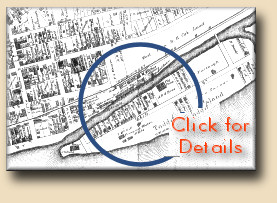
And wouldn't you know, that's the same year that Smith places the purchase by Guckenheimer of the "Williamson & Rhey" distillery.
Look at the map again, and you'll see a very large, but
unnamed, distillery compound, shown with unusual, building-by-building
detail, located in the exact area described in this section. The map's
listings of property owners also shows plainly that J. S. Bole and T.
McGill (Magill) are already major holders of land here.
In December of 2003, Ryan Kennedy wrote to us about his
great-great-great grandfather, John T. Kennedy who lived in Freeport with his
family at that time. Their home was on Todd's Island, and can be seen on
the 1876 Freeport map, adjacent to T. McGill's property and the Freeport
Woolen Mills. In 1879 they left Freeport and sold the property to
Guckenheimer Bros., which Ryan confirms was indeed the group of distillery
buildings directly across the channel. That channel is no longer there, by
the way, so what was once Todd's "Island" is no longer separated from the old shoreline.
The distillery existed pretty much where we had expected it be, although
there is no trace of its existence today, nor much of anything else. We were, in fact, parked on the site
when we asked and were given directions to the Schenley distillery by a
local citizen.
So, was Rhey (otherwise unidentified) the "Rhey" of "Williamson & Rhey"?
And, if so, then was Bell (also otherwise unidentified) "Thomas Bell", the distiller?
Or
was Thomas Bell really the owner (perhaps along with Rhey) of another,
completely different
property erroneously identified as the Moyer
Distillery in the county tax assessment?
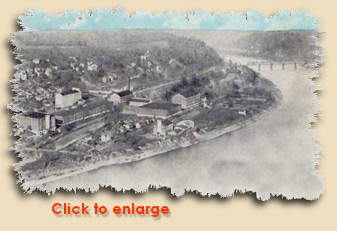
And was the reference to "Thomas Bell" in the Pittsburgh
Gazette-Times (and subsequently in the Snyder database) the result of
confusing the name "Thomas Bell" (who might still be listed as the owner in
some records) and the actual
owners "Thomas McGill" and "John Bole?" It doesn't take a difficult stretch of
imagination to see the potential for corrupting "Thomas" McGill and John
"Bole" into "Thomas Bole" (or "Bell"). That would make
about as much sense as everything else we've learned.
This old postcard shows Freeport in the early 1900s. Todd's Island and the
channel are easy to discern, the woolen mills and A. G. & Bros' pig lot,
as shown on the 1876 map can be located for reference. Thus, the group of
very large buildings on both sides of the channel between the rest of the
town and the island would have to
be the Guckenheimer Bros Distillery.
Or somebody's.
In J. Scott Bevan's letter, he writes of two warehouses on the north side of Market Street, between Fifth and Sixth, as well as a couple other buildings from the distillery still standing.
That was in 1981.
Those buildings would have been empty for a long, long time by then.
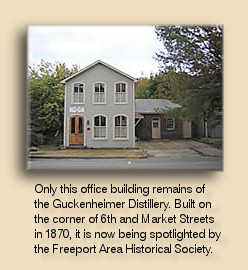
In 1920, when the Volstead Act went into effect, literally hundreds of distilleries, large and small, were suddenly left with nothing of value except their scrap copper and their brand names. And for both of those there were scavengers offering to buy up everything available at pennies on the dollar. Great, gleaming copper stills got melted down and reused for other things. Brand names got "melted down and reused", too, sort of. They were accumulated and used to label medicinal whiskey. Or just bought and sold by speculators who believed that prohibition wouldn't work out and would be repealed.
Silly
speculators! What do THEY know?
Thirteen years later, prohibition became the only Constitutional Amendment
ever to be repealed. And along with it went the Volstead Act. Silly
speculators became industry leaders overnight. The Pennsylvania Distilling Company,
now owned by Irwin and Morris Weiner and located in Logansport,
re-established some of its brands, including Guckenheimer. For awhile, it might have been
Guckenheimer whiskey from their own warehouses being bottled under their
name, but even that
eventually ran out.
As did the relationship between the Weiner brothers. This we learned in
correspondence a couple years ago with Hilary Weiner Elliot, daughter of
Irwin Weiner. She remembers that nearly the whole town of Logansport was
employed by the Pennsylvania Distilling Company at that time. Unable to reconcile
their differences, Irwin and Morris dissolved their partnership in 1940 or
'41 and sold
the company.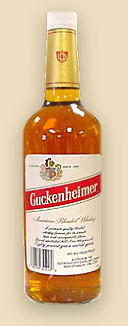 Ms. Elliot believes it was sold either
to Schenley or to National Distillers, she wasn't sure which. Actually, it
was probably to Adolph Hirsch (of A. H. Hirsch & Michter's fame) and his
partners who are known to have purchased the Pennsylvania Distilling
Company at around that time, changing its name to the Logansport
Distilling Company. It's interesting to speculate whether any relationship
might exist between Michter's whiskey and whiskey produced by
Guckenheimer.
Ms. Elliot believes it was sold either
to Schenley or to National Distillers, she wasn't sure which. Actually, it
was probably to Adolph Hirsch (of A. H. Hirsch & Michter's fame) and his
partners who are known to have purchased the Pennsylvania Distilling
Company at around that time, changing its name to the Logansport
Distilling Company. It's interesting to speculate whether any relationship
might exist between Michter's whiskey and whiskey produced by
Guckenheimer.
At any rate, by the end of the forties, the Pennsylvania
Distilling Company was sold to Schenley. The Guckenheimer brand itself was eventually sold
to the American Distilling Company in Pekin, Illinois. They used it for
several years, along
with it's trademark "Good Old Guckenheimer" slogan, to market a straight
bourbon whiskey which they made for awhile
 (quite an insult for a brand once considered
to be among America's premier rye whiskeys) in Illinois,
then bottled using commercial-grade bourbon from Kentucky, and then they
even further degraded it to a blended whiskey. American Distilling itself
eventually pooped out, its brands being acquired by Heaven Hill in
Bardstown, Kentucky. "Good
Old Guckenheimer" remains available today as an 80º
proof blended whiskey, and may be found on the bottom
shelf of liquor stores in some areas.
(quite an insult for a brand once considered
to be among America's premier rye whiskeys) in Illinois,
then bottled using commercial-grade bourbon from Kentucky, and then they
even further degraded it to a blended whiskey. American Distilling itself
eventually pooped out, its brands being acquired by Heaven Hill in
Bardstown, Kentucky. "Good
Old Guckenheimer" remains available today as an 80º
proof blended whiskey, and may be found on the bottom
shelf of liquor stores in some areas.
This year we received an email from Bud Skinner, who went through a lot of trouble to contact us. Bud wanted to share with us a photograph of his father, as a very young child, taken in front of his family's Freeport home. In the background can be seen the smokestack and distillery building of A. Guckenheimer & Bros. as it was in about 1915. We love this picture. In many ways, it says what it is that we love so much about our obsession with American whiskey. It's really not about alcohol, or nation-building, or connoisseur-ship, or whether they just don't make 'em like they used 'ter anymore, even though it's about all of those things. It's about how, nearly a hundred years ago, a kid just like me loved his pail and favorite elf figure so much that he'd even agree to endure getting his picture taken as long as he could have them around.
Oh... and yeah, there was a distillery there, too.
Also, J. Scott Bevan related a couple a word-pictures you might
enjoy as much as we did...
|
" ... wanted to pass along a little information on the Guckenheimer Distillery [and] a gentleman named Herman Sarver (he was about 103 years old when he died a few years ago)." |
Note: the Sarver
family are among the very first settlers in the region. The nearby town of
Sarverville is named for them and they figure in many of the communities in
the area, including Freeport. Bevan goes on to say...
|
"I
worked bailing hay for Ol’ Herman as a boy and even raided his corn fields
for corn-on-the-cob campfires (work by day, raid by night)
Ol' Herm’s farm located in South Buffalo Twp on Sunset Drive had raised
corn, rye, alfalfa for feed for a number of years but as kids growing up we
had heard and knew Herm had at one time (and still did) raised corn and rye
(sold direct) for whiskey being distilled at the Schenley Distillery (Jos.
Finch and Sons) in Schenley, PA. Many an hour was spent looking for
bottles of booze in his out buildings. I even remember seeing a
“line-up” of dusty, cobwebbed bottles sitting on a window sash having been
long ago drunk and “cooked” off by the suns rays streaming through the
window. Tobacco juice colored remnants of that prized syrupy liquor
huddled in the corners of those bottles. Alas, if only it could have been
reconstituted. One of those bottles was definitely a
Guckenheimer (I called it Guggenheim ala Jackie Gleason’s Crazy Guggenheim).
A story was told that every other year a barrel of Schenley Whiskey was
delivered to Herm Sarver’s home as something Schenley just did..." | |
 |
|
|
Story and original photography copyright © 2006 by John F. Lipman. All rights reserved. |
|


